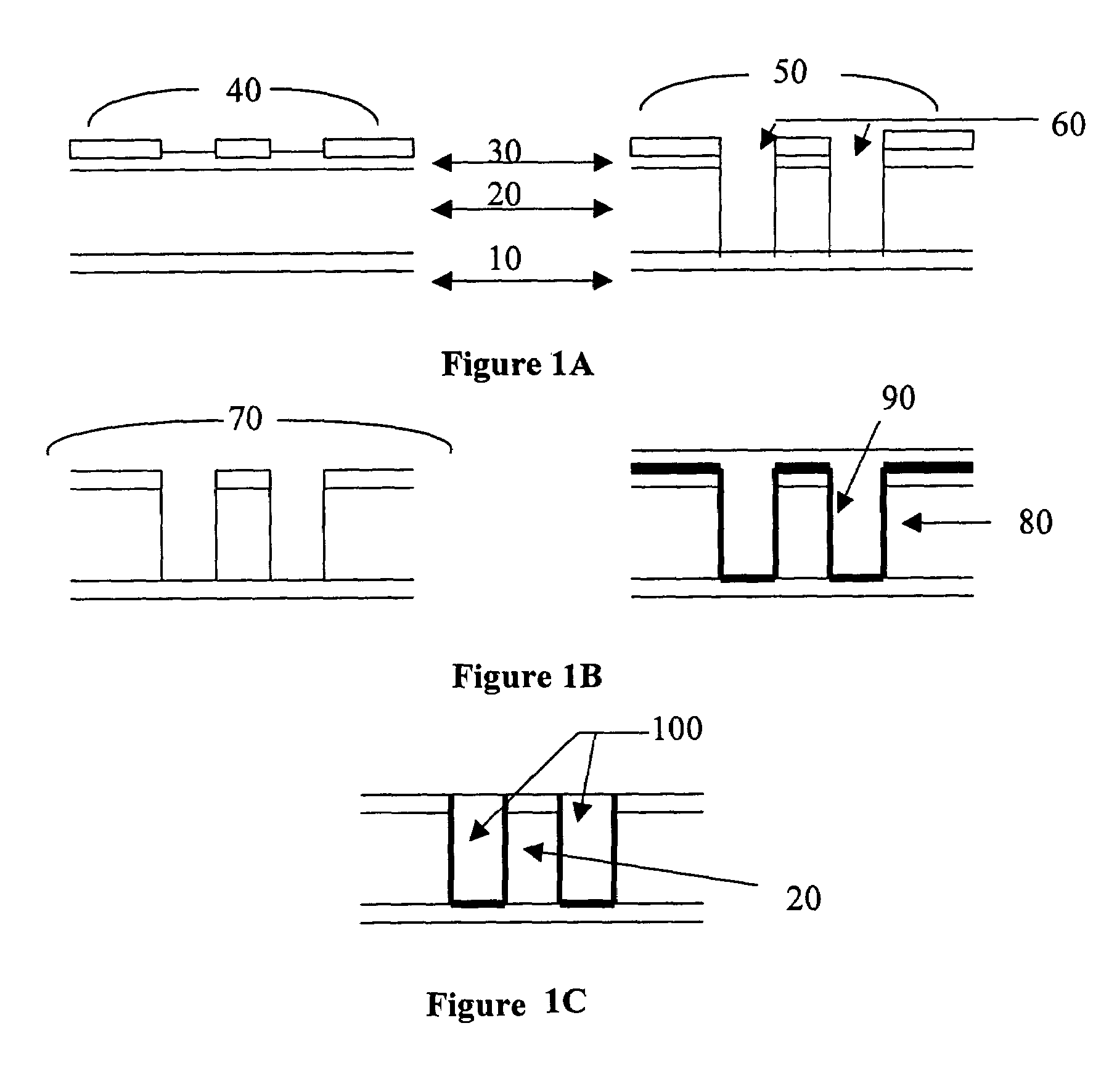Method to restore hydrophobicity in dielectric films and materials
a technology of applied in the field of restoration of hydrophobicity in dielectric films and materials, can solve the problems of increasing power consumption and signal cross-talk, interconnection rc delay, undesirable properties,
- Summary
- Abstract
- Description
- Claims
- Application Information
AI Technical Summary
Benefits of technology
Problems solved by technology
Method used
Image
Examples
example 1
Formation of Nanoporous Silica Film Treated with MTAS
[0064]A nanoporous silica precursor was synthesized as described by co-owned U.S. Ser. No. 09 / 235,186, filed on Jan. 22, 1999, incorporated by reference herein. Thus, the precursor was prepared by adding 208 mL of tetraethoxysilane, 94 mL of triethyleneglycol monomethyl ether(TriEGMME), 16.8 mL deionized water, and 0.68 mL of 1N nitric acid together in a round bottom flask. The solution was allowed to mix vigorously and heated (heating and stirring were begun at the same time) to about 80° C. and refluxed for 1.5 hours, to form a clear solution. The resulting solution was allowed to cool down to room temperature and then it was diluted 25% by weight with ethanol, and filtered through a 0.1 micron Teflon® filter.
[0065]About 2 mL of the nanoporous silica precursor was deposited onto a 4″ silicon wafer and then spun at 2500 rpm for 30 seconds. Then the film was gelled / aged in a vacuum chamber using the following conditions:[0066]1. T...
example 2
Formation of Non-Porous Methylhydridosiloxane Film
[0075]A precursor composition was prepared as described by U.S. patent application Ser. No. 09 / 044,798, filed on Mar. 20, 1998, the disclosure of which is incorporated by reference herein. Thus, a one liter jacketed reactor equipped with a nitrogen inlet, dry ice condenser and a mechanical stirrer was charged with 1000 mL hexanes, 80 mL ethanol, 25 mL water and 61.3 g Amberjet 4200 catalyst (Rohn & Haas Co.). The mixture was equilibrated for 0.5 hr with stirring at 25° C. (circulating bath). A mixture of trichlorosilane (14.3 mL, 0.142 Mol) and methyltrichlorosilane (66.7 mL, 0.568 Mol) was added to the reactor using a peristaltic pump over a period of 35 minutes. Upon completion of the silane addition, hexane was pumped through the lines for 10 minutes. The reaction was stirred for 23 hours, then filtered through a Whatman #4 filter. The filtered solution was placed in a separatory funnel and the water / ethanol layer removed. The rem...
example 3
[0078]The wafer coated with nanoporous silica in Example 1 is placed within the chamber of a TEL 85 DRM L3510 etcher. Pure oxygen is made to flow through the chamber at less than 500 sccm. The wafer temperature is 25° C. An RF plasma source is activated at a power consumption level of 500 W for a period of 1 minute. During this 1 minute period the film is exposed to a plasma derived from oxygen. The total pressure during this process is less than 500 millitorr. The predicted film properties before and after this ashing treatment are:
[0079]
TABLE 2ThicknessRIkC—H Abs.Before7050 Å1.1652.20.15After69601.1603.80.02
[0080]Fourier transform infrared (“FTIR”) spectroscopy confirms that the O—H absorption curve is increased in amplitude at about 3500 cm−1 in films subjected to the ashing treatment, relative to untreated (non-ashed) films. This confirms that the ashing treatment removes most of the C—H bonds attributable to the methyl groups in the original film. It has previ...
PUM
| Property | Measurement | Unit |
|---|---|---|
| feature sizes | aaaaa | aaaaa |
| dielectric constants | aaaaa | aaaaa |
| dielectric constant | aaaaa | aaaaa |
Abstract
Description
Claims
Application Information
 Login to View More
Login to View More - R&D
- Intellectual Property
- Life Sciences
- Materials
- Tech Scout
- Unparalleled Data Quality
- Higher Quality Content
- 60% Fewer Hallucinations
Browse by: Latest US Patents, China's latest patents, Technical Efficacy Thesaurus, Application Domain, Technology Topic, Popular Technical Reports.
© 2025 PatSnap. All rights reserved.Legal|Privacy policy|Modern Slavery Act Transparency Statement|Sitemap|About US| Contact US: help@patsnap.com


